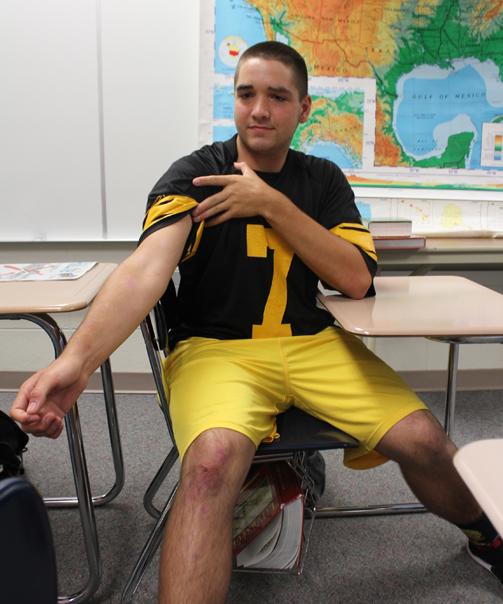Football player and junior Grant Wood wasn’t very concerned when a small bump first appeared on his body.
“At first I thought that it was a turf burn; it started off as kind of like acne spot… and it started getting bigger, and it started spreading (wherever) it touches,” Grant said. “That’s when I knew it wasn’t turf burn.”

After he brought the infection to the attention of his athletic trainers and coaches, Grant was quickly sent to his family physician for treatment for the bacterial disease methicillin-resistant Staphylococcus aureus (MRSA).
MRSA is a variation of staph infection which has a heightened resistance to antibiotics and can spread onto a variety of materials, such as lockers and other equipment. Athletics Director Jim Inskeep said that a process known as ‘fogging’ is currently used to decontaminate surfaces inside the school potentially infected with MRSA.
“The football locker room (was) treated multiple times, and we’ll continue to do that for the rest of the season,” Inskeep said. He also added that a number of locker room areas were also treated as a precautionary measure, along with the physical education areas of CHS.
Of course, people infected with MRSA can still serve as vectors for the spread of the disease. However, Wood is no longer contagious by medical standards, and continues to attend CHS with only a few scars on his body as a reminder of his encounter with MRSA. Influenced by his experience with the disease, he had this to say to his fellow athletes.
“If anything looks different or abnormal, just get it looked at. I mean, it can’t hurt to ask a trainer to see what he has about it. Grant said. “The sooner you get it checked out, the better.”































![What happened to theater etiquette? [opinion]](https://hilite.org/wp-content/uploads/2025/04/Entertainment-Perspective-Cover-1200x471.jpg)













































![Review: “The Immortal Soul Salvage Yard:” A criminally underrated poetry collection [MUSE]](https://hilite.org/wp-content/uploads/2025/03/71cju6TvqmL._AC_UF10001000_QL80_.jpg)
![Review: "Dog Man" is Unapologetically Chaotic [MUSE]](https://hilite.org/wp-content/uploads/2025/03/dogman-1200x700.jpg)
![Review: "Ne Zha 2": The WeChat family reunion I didn’t know I needed [MUSE]](https://hilite.org/wp-content/uploads/2025/03/unnamed-4.png)
![Review in Print: Maripaz Villar brings a delightfully unique style to the world of WEBTOON [MUSE]](https://hilite.org/wp-content/uploads/2023/12/maripazcover-1200x960.jpg)
![Review: “The Sword of Kaigen” is a masterpiece [MUSE]](https://hilite.org/wp-content/uploads/2023/11/Screenshot-2023-11-26-201051.png)
![Review: Gateron Oil Kings, great linear switches, okay price [MUSE]](https://hilite.org/wp-content/uploads/2023/11/Screenshot-2023-11-26-200553.png)
![Review: “A Haunting in Venice” is a significant improvement from other Agatha Christie adaptations [MUSE]](https://hilite.org/wp-content/uploads/2023/11/e7ee2938a6d422669771bce6d8088521.jpg)
![Review: A Thanksgiving story from elementary school, still just as interesting [MUSE]](https://hilite.org/wp-content/uploads/2023/11/Screenshot-2023-11-26-195514-987x1200.png)
![Review: "When I Fly Towards You", cute, uplifting youth drama [MUSE]](https://hilite.org/wp-content/uploads/2023/09/When-I-Fly-Towards-You-Chinese-drama.png)
![Postcards from Muse: Hawaii Travel Diary [MUSE]](https://hilite.org/wp-content/uploads/2023/09/My-project-1-1200x1200.jpg)
![Review: "Ladybug & Cat Noir: The Movie," departure from original show [MUSE]](https://hilite.org/wp-content/uploads/2023/09/Ladybug__Cat_Noir_-_The_Movie_poster.jpg)
![Review in Print: "Hidden Love" is the cute, uplifting drama everyone needs [MUSE]](https://hilite.org/wp-content/uploads/2023/09/hiddenlovecover-e1693597208225-1030x1200.png)
![Review in Print: "Heartstopper" is the heartwarming queer romance we all need [MUSE]](https://hilite.org/wp-content/uploads/2023/08/museheartstoppercover-1200x654.png)



